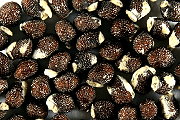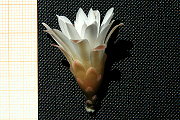Gymnos from A to Z
Gymnocalycium chacoense Amerhauser
The plants were only found on the Cerro Miguel so far and, for me, are one of the most beautiful discoveries of the last decades. The species grows on steep rock faces on the topmost third of the mountain. This habitat is a relic site. The plants are closely related to G. chiquitanum and G. paediophilum, but took a different development due to their isolated location. Hans Till placed the species as a seperate Sieries (Chacoensiana) within the Subsectio B1 Microsemineum in his "Realignment of the Genus Gymnocalycium". He seperates them from G. chiquitanum and G. paediophilum based on the colour of the flowers' gullets and the Hilum-Mikropylar region of the seeds. In my opinion, this is an unnecessary division, since the seeds are very similar and there are mutual flower characteristics. For me, therefore, all three species belong to the Sieries f chiquitana Till.
Plant
(Description according to Amerhauser in Gymnocalycium 12 (4) 1999)
They are wide, spherical plants, 40 to 75 mm in height, 55 to 80 mm in diameter, strongly sprouting at old age and thus forming groups of 15 to 25 specimen with rich, fibrous shallow roots. Epidermis light green, faintly gleaming, 8 to 12 ribs, straight, mostly rounded, in part slightly canted, hardly raised onset of protuberance. Areoles 14 to 15 mm apart, round 3 mm in diameter with yellowish white tomentum, which lasts for quite some time with younger plants and quickly turns bald with old plants. 7 to 9 border spines - 8 to 10 mm on top, 16 to 19 mm in the middle, 13 to 15 mm at the bottom - and three central spines, 16 to 21 mm in length, protrudin from the body, straight to slightly bent, when freshly sprouting light yellow with brown top, later turning grey. All thorns are thin, bristly, firm, yet flexible.
Seed
Core cavity 2 mm in height, 2.5 mm in diameter, round, cropped on top, white wall with numerous white spermatic cords. Fruit small, juicy, 6 to 8 mm in height, 4 to 5 mm thick, green, later dry. Seeds on the gelatinous agglutinated spermatic cords. Seeds small, 1 mm in length, 0.7 mm thick, auburn, gleaming, highly tubercular, Hilum–Mykropylar region slightly crooked with large elaiosome.
Flower
Flowers are near the apex, slender funnel-shaped, often in large number, 35 to 45 mm in length, 20 to 32 mm in diameter, white to pinkish, with chartreuse gullet. Ovary flat, spherical, 3 mm in height, 4 mm in width, magenta-pink, densely scaled, no hairs or bristles. Scales semicircular, pink with wide lighter brim, which - stretching - fade to the outer petals. Outer petals spatulate, 15 to 18 mm in length, light magenta-pink with wide whitish margin, endings slightly bent to the outside. Inner petals wide lanceolate, 18 mm in length, 6 mm in width on the widest point, lacteal white. Filaments thin, chartreuse, inserted along the whole tube wall, 9 mm in length, two thirds lie close to the tube wall, the topmost third bent to the inside, far overlapping the style. Anthers oval, 1 x 0.5 mm in diameter, yellow with yellow pollen. Style 7 mm in length (9 mm with stigma), 1.1 mm thick, chartreuse, barely overlapping the lowest row of anthers. Stigma 2 mm in length with 7 claw-shaped white stigma branches.







